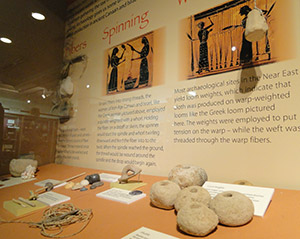 Dr. Karen Bowden Cooper ’98 holds one of the most inherently interesting jobs at Pittsburgh Seminary: she manages and exhibits the ancient artifacts housed in the Kelso Museum of Near Eastern Archaeology. As curator of the Museum and lecturer in Hebrew, Karen works with her staff of students to see that the collection is properly conserved, handled, and displayed in ways that enlighten visitors’ understanding of the biblical world and the ancient Near East.
Dr. Karen Bowden Cooper ’98 holds one of the most inherently interesting jobs at Pittsburgh Seminary: she manages and exhibits the ancient artifacts housed in the Kelso Museum of Near Eastern Archaeology. As curator of the Museum and lecturer in Hebrew, Karen works with her staff of students to see that the collection is properly conserved, handled, and displayed in ways that enlighten visitors’ understanding of the biblical world and the ancient Near East.
“More than 3,000 visitors a year come to the Museum to browse or for tours, which the staff tailors to the composition and interests of the group,” Karen notes. “For young visitors and the young-at-heart we offer hands-on activities with ancient artifacts (given for educational purposes) and exercises that introduce the Greek and Hebrew alphabets and the cuneiform and hieroglyphic systems.”
As complements to the Kelso’s core exhibit, rooted in sites such as Bab edh Dhra, Tell Beit Mirsim, Beitin/Bethel, and Herodian Jericho and organized chronologically from the Early Bronze through early the Islamic period, the Museum staff has mounted exhibits that examine ancient technologies; the roots of the alphabet in the traditions of writing in Mesopotamia and Egypt; and the traditions of ceramic production by hand, slow wheel, and fast wheel.
 “The latest addition to the Kelso Museum,” notes Karen, “is The Fabric of Everyday Life—an exhibit that displays the materials and tools of cloth production in the ancient Levant and acknowledges the central role of women in all stages of the gathering and preparation of fibers and dyes, spinning, weaving cloth, and finally sewing garments.” She continues, “From the Museum’s own collection, the exhibit features spindles, whorls, a spinning bowl, loom weights, and shuttles. It also displays fibers, wool in stages of preparation, and flax, which has to go through even more processing than wool before spinning begins.”
“The latest addition to the Kelso Museum,” notes Karen, “is The Fabric of Everyday Life—an exhibit that displays the materials and tools of cloth production in the ancient Levant and acknowledges the central role of women in all stages of the gathering and preparation of fibers and dyes, spinning, weaving cloth, and finally sewing garments.” She continues, “From the Museum’s own collection, the exhibit features spindles, whorls, a spinning bowl, loom weights, and shuttles. It also displays fibers, wool in stages of preparation, and flax, which has to go through even more processing than wool before spinning begins.”
The research behind the new exhibit is rooted in the work of Elizabeth Wayland Barber, professor emerita at Occidental College, Los Angeles. In April Dr. Barber spoke on the archaeology of textile production in the Museum’s lecture series. During her time on our campus, she advised the staff as the exhibit came together.
In September Karen will open another new exhibit, Tell er-Rumeith: An Outpost on the Incense Road, which highlights a small Iron Age site in northern Jordan excavated by Paul Lapp in 1967. “It will bring into focus grain and incense production and trade,” Karen notes. She and her staff are always eager to introduce visitors to the people of the ancient Near East through the artifacts they’ve left behind.
Admission to the Kelso Museum of Near Eastern Archaeology and parking are free. Open hours are from 10:00 a.m. -4:00 p.m. (September-May) / 12:00-4:00 p.m. (June-August). Tours for individuals and classes may be scheduled by calling 412-924-1394. Learn more about visiting the Museum.
